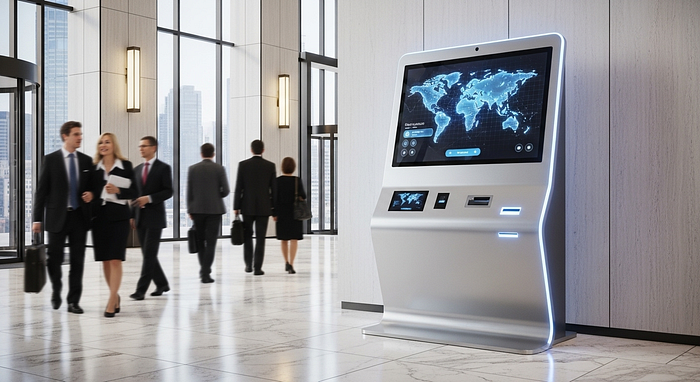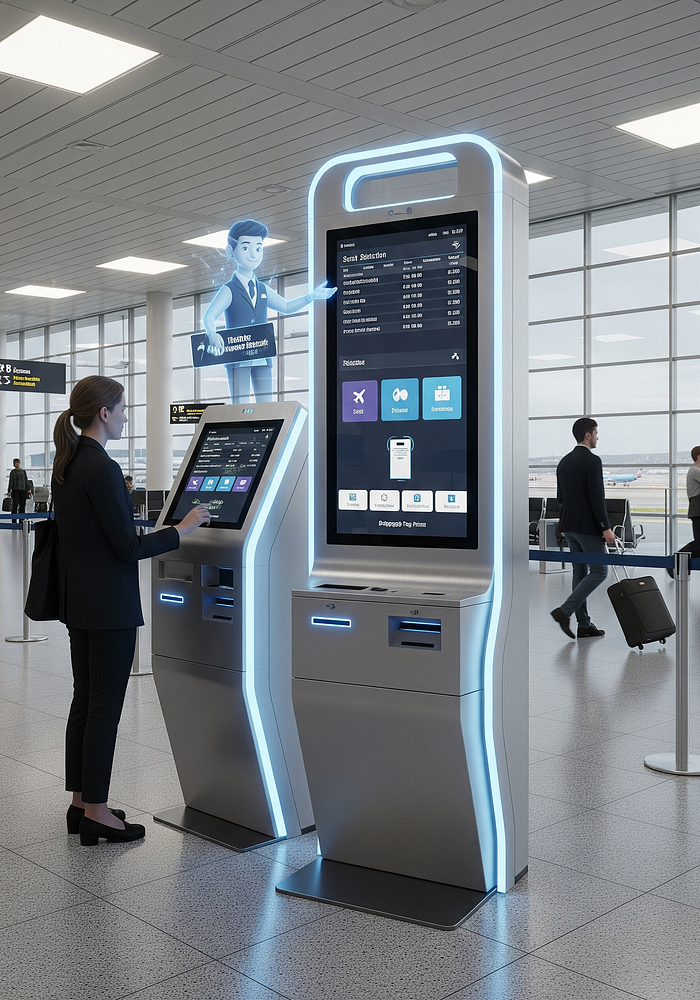Smarter Airports: Why Self-Service Kiosks Are Key to Faster, Easier, and Greener Travel

The modern airport landscape has transformed dramatically over the last few decades. With the global increase in air travel, the number of passengers passing through major international and regional airports continues to rise year after year. According to the International Air Transport Association (IATA), global passenger traffic is expected to surpass 8 billion by 2037. This rapid growth puts immense pressure on airport infrastructure, requiring innovative solutions to maintain efficiency and improve the passenger experience.
One of the most notable technological advancements in recent years is the rise of self-service kiosks. These automated machines, designed to streamline various aspects of the airport journey, have become ubiquitous at airports worldwide. From check-in and boarding pass issuance to baggage tagging and real-time flight updates, self-service kiosks provide a faster, more convenient alternative to traditional service counters.
This blog explores the significant role self-service kiosks play in shaping smoother, faster, and more personalized airport experiences for travelers of all types, while also reducing costs and enhancing sustainability efforts.
Speeding Up Check-In and Boarding Processes
Airports are busy hubs of activity, and long queues at check-in counters have long been a source of frustration for travelers. The introduction of self-service kiosks is a game-changer, significantly speeding up check-in and boarding processes by automating many repetitive tasks.
Self-Service Check-In Benefits
Self-service kiosks empower passengers to independently manage their check-in process. Upon approaching a kiosk, travelers can simply scan their passport, enter their booking reference, or use frequent flyer information. The interface is typically intuitive and offers step-by-step guidance, enabling passengers to:
- Select or change their seats.
- Specify baggage requirements.
- Handle special requests such as meal preferences or accessibility assistance.
This process greatly reduces reliance on counter agents, enabling even shy or independent travelers to complete check-in efficiently. It also frees up staff to focus on handling complex or exceptional cases, thereby improving overall service quality.
Efficient Boarding Pass Printing and Baggage Tagging
A key feature of airport kiosks is the ability to print boarding passes and baggage tags without the need for human interaction. Passengers can print their boarding passes directly at the kiosk after completing check-in, and if they have checked luggage, the system generates baggage tags as well.
This process simplifies the journey through security checkpoints and baggage drop-off points. Rather than waiting for counter service, passengers can proceed directly to designated drop-off areas, reducing congestion and wait times, especially during peak travel periods.
Moreover, 24/7 kiosk availability ensures that travelers arriving at odd hours can complete necessary processes without delay, improving the airport’s operational efficiency.
Enhancing Passenger Convenience and Personalization
Beyond speeding up basic check-in and boarding steps, modern self-service kiosks offer advanced features that significantly enhance passenger convenience and personalization.
Multi-Language and Accessibility Features
Airports serve a global audience, and language barriers can be a major challenge. Self-service kiosks address this by offering multiple language options, enabling international travelers to complete transactions in their preferred language.
In addition, many kiosks are designed with accessibility in mind. Touchscreen interfaces are supplemented by audio assistance, larger fonts, and options for the visually impaired. This inclusive design ensures that passengers with disabilities can navigate the process comfortably and independently, promoting a more equitable travel experience.
Customizing Travel Preferences Through Kiosks
Self-service kiosks are not just functional — they provide opportunities for personalized service. By integrating with frequent flyer accounts and travel profiles, kiosks can suggest seat upgrades, pre-selected meal options, and highlight special promotions.
For example, a business traveler may receive a prompt offering an upgrade to a business class seat, while a family traveling with children may be shown options for seats closer to restrooms. This customization reduces the need for direct interaction with airline staff and helps passengers feel in control of their journey.

Reducing Operational Costs and Environmental Impact
For airlines and airport operators, self-service kiosks represent a strategic investment in operational efficiency and sustainability.
Cost Benefits for Airlines and Airports
Traditional check-in counters require significant staffing, especially during busy periods. Kiosks, by automating routine tasks such as check-in and baggage tagging, reduce the need for large numbers of service personnel. This leads to considerable labor cost savings.
Moreover, the saved resources can be reallocated to enhance other airport services, such as improving lounge areas, adding more security checkpoints, or maintaining better facilities, or can be reflected in more competitive ticket pricing for travelers.
Promoting Eco-Friendly Travel Practices
Environmental impact is a growing concern in the aviation industry, and kiosks contribute positively to this by promoting eco-friendly practices. Many kiosks now offer digital boarding passes and e-receipts, minimizing the need for paper printing. This not only reduces paper waste but also decreases the energy consumption associated with printing and handling paper documents.
Airports equipped with digital systems are better aligned with global sustainability goals, reducing their carbon footprint and improving the overall green image of air travel.
Improving Information Accessibility and Real-Time Updates
A major source of travel anxiety stems from uncertainty — unawareness of gate changes, flight delays, or airport navigation issues. Self-service kiosks mitigate these problems by providing up-to-the-minute information directly to passengers.
Real-Time Flight and Gate Information
Kiosks display current flight statuses, including departure and arrival times, gate assignments, and notifications of any delays or cancellations. This real-time information empowers passengers to adjust their travel plans as needed, reducing stress and enabling smoother connections.
For example, if a gate change occurs, the kiosk will instantly display the new information, giving the passenger time to plan their route accordingly without needing to wait for an announcement or staff assistance.
Guided Airport Navigation and Services
Large airport terminals can be confusing, especially for first-time visitors. Kiosks offer interactive maps and step-by-step directions to gates, lounges, restrooms, restaurants, and baggage claim areas. Passengers can search for specific services and get personalized route guidance.
These features not only enhance wayfinding but also help prevent bottlenecks at information desks, reducing overall terminal congestion.
Conclusion
In the fast-paced world of air travel, self-service kiosks have emerged as vital tools for improving both operational efficiency and passenger experience. They speed up the check-in and boarding process, provide personalized service options, support accessibility and multi-language needs, reduce staffing and operational costs, promote eco-friendly travel practices, and offer real-time flight updates and guided navigation.
For passengers, kiosks offer an independent, convenient, and efficient way to manage their airport experience. For airlines and airports, kiosks reduce overhead costs while contributing to a more sustainable and customer-friendly environment.
As air travel continues to grow in volume and complexity, embracing self-service kiosk technology is no longer just an option — it’s a necessity. Travelers are encouraged to make the most of these advancements to enjoy smoother, faster, and more pleasant airport journeys.
Comments
Post a Comment